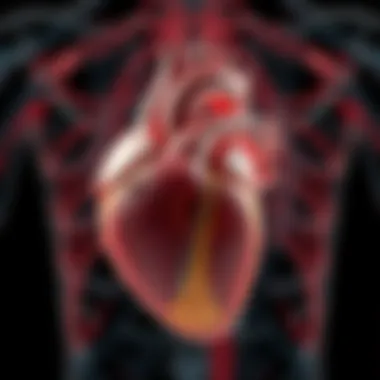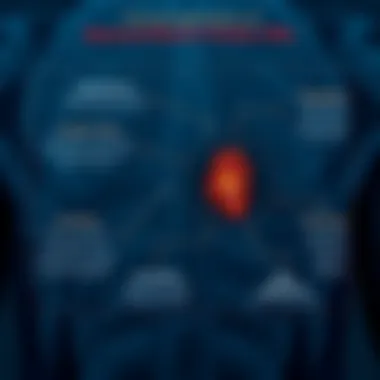Understanding Normal Ejection Fraction and Its Impact


Intro
Ejection fraction, a term that resonates within both clinical and wellness circles, serves as a vital indicator of heart health. But what exactly is it? Essentially, ejection fraction measures the percentage of blood that the heart pumps out with each contraction. Normal values typically hinge around 55% to 70%. This range is not just a number; it represents how efficiently the heart is functioning—a well-oiled machine, if you will.
As we explore the nuances of normal ejection fraction, it becomes evident that this metric is influenced by various factors including age, gender, and underlying health conditions. Understanding these elements can empower both patients and healthcare professionals in monitoring cardiovascular health. This article aims to dissect ejection fraction thoroughly, shedding light on its significance and the implications of abnormal values, offering a roadmap to informed decision-making in heart care.
Research Overview
Summary of Key Findings
A few key takeaways stand out in the discussion surrounding ejection fraction. First and foremost, maintaining an ejection fraction within the normal range is crucial for preventing heart diseases. A decrease in this value often points to issues needing immediate attention, such as heart failure or cardiomyopathy. Additionally, the research reflects significant demographic variations. For instance, studies suggest that women may exhibit slightly higher ejection fractions compared to men. In older populations, the normal range can shift, highlighting the importance of tailored assessments.
Background and Context
The concept of ejection fraction began to gain traction in the medical community during the late 20th century, coinciding with advancements in echocardiography technology. This technique enables health professionals to visualize heart chambers in action, revealing valuable insights into how well the heart pumps blood. Given the heart's pivotal role in human physiology, understanding its performance metrics like ejection fraction is integral to both preventative and curative healthcare approaches.
"A heart that beats with resilience often pumps at a rate that echoes health; understanding its performance can change lives."
Methodology
Experimental Design
Studies focused on ejection fraction often utilize longitudinal research designs, encompassing both observational and interventional frameworks. These designs allow researchers to trace changes in ejection fraction across various demographics over time, providing a comprehensive view of cardiovascular health trends.
Data Collection Techniques
Data collection is typically executed through diverse methods, including:
- Echocardiograms: Non-invasive tests offering real-time imaging of heart functionality.
- MRI Scans: Advanced imaging providing detailed heart structure analysis.
- Clinical Trials: Evaluating the impact of medications or interventions on ejection fraction.
Each of these methods contributes to a better understanding of what constitutes a 'normal' ejection fraction while also helping delineate any deviations that merit further investigation. By consolidating this information, health professionals can formulate an effective plan to optimize heart health, catering specifically to the unique needs of each patient.
For additional insights, refer to resources like National Heart, Lung, and Blood Institute and American Heart Association for in-depth discussions and latest research findings.
Defining Ejection Fraction
Ejection fraction is a term that often pops up in conversations about heart health. It's a simple way to quantify how well the heart is doing its job. In this section, we'll focus on the importance of understanding ejection fraction, why it matters, and the key elements that make it a vital statistic in cardiology.
Basic Concept of Ejection Fraction
At its core, ejection fraction refers to the percentage of blood that the heart pumps out with each contraction. Imagine a sponge that soaks up water; when you squeeze it, some liquid is expelled. Similarly, the heart fills with blood and then ejects a portion of that blood with each heartbeat.
A normal ejection fraction typically ranges from 55% to 70%. When the heart contracts effectively, this range indicates that enough blood is being supplied to meet the body's needs. Conversely, a low ejection fraction might signal underlying issues, implying the heart isn't pumping efficiently.
This understanding is particularly crucial for both patients and healthcare providers. A lower ejection fraction can mean the heart is struggling, while a higher value can suggest that it's functioning well. Monitoring changes in ejection fraction can also provide insights into the progression or improvement of heart disease.
Calculation Methodology
Now, let's clear the air about how ejection fraction is calculated. The most straightforward formula is simple: it’s the ratio of the volume of blood pumped from the ventricle in one heartbeat to the total volume of blood in the ventricle before contraction. To express it mathematically:
- Stroke Volume is the amount of blood ejected with each heartbeat.
- End-Diastolic Volume is the total amount of blood in the ventricle before contraction.
Healthcare professionals often use echocardiograms to measure these volumes, identifying the efficiency with which the heart pumps blood. This can be verifiable through techniques involving ultrasound, MRI, or even cardiac catheterization for more detailed investigations.
Calculating ejection fraction allows clinicians to make informed decisions regarding treatment strategies, and has significant implications for evaluating heart health.
In summary, defining ejection fraction entails understanding not just the numbers, but the real impact these statistics have on one’s health. As we proceed in this article, we will explore normal ranges of ejection fraction, factors that influence these measurements, and their clinical relevance.
Normal Ranges for Ejection Fraction
Understanding the normal ranges for ejection fraction is fundamental in cardiovascular health. This value provides insight into how effectively the heart functions as a pump, supplying blood to the body. Being aware of what constitutes a normal ejection fraction can help identify potential health issues before they become problematic.
Normal ejection fractions, generally indicated between 50% and 70%, can show considerable variance based on individual characteristics such as age and gender. Monitoring this value can lead to early detection of heart-related conditions, ensuring timely and effective interventions. Thus, a deeper look into what defines a normal value is warranted.


What Constitutes a Normal Value
A normal ejection fraction indicates that the heart is efficiently contracting to pump blood. On average, values between 55% and 70% are deemed normal, but slight deviations can still fall within a healthy range depending on individual circumstances.
- Young Adults: For most young adults, a normal ejection fraction is often closer to the upper end, typically between 60% to 70%. This reflects robust cardiac function.
- Elderly Population: As individuals age, it’s not uncommon for the normal range to shift a bit lower, possibly bordering around 50% to 65%. This change can be natural, stemming from age-related physiological changes.
Factors such as physical fitness and the presence of cardiovascular diseases are crucial influencers of an individual's ejection fraction. Elite athletes, for instance, may exhibit ejection fractions exceeding 70%, showcasing the heart's adaptation to regular intensive training.
Interpreting Variations
Understanding variations in ejection fraction readings helps clinicians discern between normal physiological variations and potential pathological conditions. Even small fluctuations can have significant implications.
- Slightly Low Values: An ejection fraction between 40% and 55% may not immediately indicate severe heart dysfunction but warrants monitoring. Some individuals might be asymptomatic yet fall within this range, which could be normal for them due to various factors.
- Moderately Low Values: Values that dip below 40% can signal worsening cardiac function, and further investigation is typically recommended. This might include stress testing or imaging studies to assess heart structure and performance.
- High Values: While ejection fractions above 70% can suggest efficient heart function, excessively elevated values may be linked to conditions like hypertrophic cardiomyopathy or high blood pressure, emphasizing the need for a comprehensive cardiac evaluation.
"A careful evaluation of ejection fraction enables proactive responses to potential heart issues, allowing for tailored preventive strategies and treatments."
Factors Influencing Ejection Fraction
Understanding ejection fraction isn't just a matter of memorizing numbers; it's a doorway into the intricate workings of the heart. The factors influencing ejection fraction offer insights into both physiological and pathological states of the heart. With this knowledge, one can better appreciate why the heart behaves a certain way in varied scenarios. Let's dive into the pivotal influences on ejection fraction, and how they stitch together the narrative of heart health.
Cardiac Anatomy and Physiology
At the heart of ejection fraction lies the anatomy and physiology of the heart. The heart's chambers—the left and right atria, as well as the left and right ventricles—play unique roles in pumping blood. It’s particularly the left ventricle that gets all the spotlight with ejection fraction measurements, since it pumps oxygenated blood to the body. This muscle must be both strong and efficient, functioning like a well-oiled machine. Any structural abnormalities in the heart, like hypertrophy or dilatation, can easily affect how much blood is ejected.
Moreover, the heart valves, which guide blood flow, must open and close at just the right moments. If a valve is leaky or stenotic, it can mess with blood volume and consequently affect ejection fraction. It’s a delicate ballet in the cardiovascular system, where even minor missteps can lead to significant alterations in heart function.
Age and Gender Differences
Believe it or not, your age and gender can shape how your heart performs its pumping duties. As people age, the heart undergoes various changes. Muscle mass may decline, and arteries can stiffen, leading to a decrease in ejection fraction. Studies show that while younger adults often maintain a higher ejection fraction, older adults tend to experience a gradual decline. Likewise, gender variations show compelling trends; men generally have a higher average ejection fraction than women. This could be due to differences in body composition and hormonal influences, often shifting the paradigm of heart health.
For instance:
- Younger Adults: Tending to have ejection fractions in the upper normal ranges.
- Older Adults: With an inclination towards lower normal ranges, which could signal a need for proactive health measures.
Understanding these age-related and gender aspects is crucial when interpreting ejection fraction results, allowing for tailored healthcare strategies and interventions.
Impact of Health Conditions
The road to normalizing ejection fraction is often bumpy, especially when health conditions come into play. Various cardiovascular diseases, such as coronary artery disease and hypertension, hold the potential to change the dynamics of heart function. For example, in cases of heart failure, ejection fraction may plummet, acting like a red flag indicating that the heart isn't adequately pumping blood.
Additionally, conditions like diabetes and obesity exacerbate the situation, contributing to cardiovascular strain. Even seemingly unrelated factors like chronic kidney disease can influence heart dynamics.
Here’s where ejection fraction can offer clues:
- Coronary Artery Disease: Often leading to reduced ejection fraction due to heart muscle ischemia.
- Hypertension: Can lead to left ventricular hypertrophy, impacting the heart's ability to effectively pump.
- Diabetes and Obesity: Changes in blood flow dynamics and vascular health can interfere with normal ejection fractions.
Consequently, understanding the relationship between ejection fraction and these health conditions offers a roadmap for diagnosing and treating patients effectively.
In summary, the factors influencing ejection fraction are intricate and multifaceted, ranging from anatomical considerations to lifestyle choices. Each element plays an indispensable role in both influencing and interpreting ejection fraction, providing a lens through which we can view cardiovascular health holistically. To deepen your understanding, explore resources like Wikipedia and Britannica.
Clinical Relevance of Ejection Fraction
Ejection fraction (EF) serves as a critical metric in assessing heart function. Its significance extends across various pathways in cardiovascular medicine, where it not only aids in diagnosing heart diseases but also influences treatment strategies and predicts patient outcomes. Understanding the clinical relevance of ejection fraction is imperative, especially for professionals involved in cardiac care, facilitating timely interventions and improving patient prognoses.
Role in Heart Disease Diagnosis
The role of ejection fraction in diagnosing heart disease cannot be overstated. It provides a quantitative measure of how efficiently the heart pumps blood, offering insights into overall cardiac health. The normal range of ejection fraction typically falls between 55% and 70%. Deviations from this range can indicate pathological changes.
For instance, a reduced ejection fraction, often defined as less than 40%, may signal conditions such as heart failure or cardiomyopathy. On the other hand, an abnormally high ejection fraction might suggest conditions like hypertrophic cardiomyopathy. In clinical practice, medical professionals leverage this metric to identify risks and initiate preventative measures early on.
"An accurate understanding of ejection fraction can mean the difference between early intervention and a delayed diagnosis that could lead to severe complications."
Ejection Fraction and Heart Failure


Hearts functioning sub-optimally due to diminished ejection fraction are often unable to meet the body’s circulatory demands. In heart failure, the heart struggles to pump blood effectively, and monitoring ejection fraction becomes paramount.
In scenarios where ejection fraction dips below 40%, patients generally fall into the category of heart failure with reduced ejection fraction (HFrEF). On the flip side, those with heart failure but a preserved ejection fraction (HFpEF) tend to have an EF of 50% or higher. Understanding these classifications helps clinicians tailor treatments more effectively, often prescribing medications to enhance cardiac performance.
Predictive Ability for Cardiac Events
Another significant aspect of ejection fraction is its predictive capacity regarding future cardiac events. Research indicates that patients with lower ejection fractions have a higher risk of adverse cardiovascular events, including arrhythmias, hospitalization, or even death.
Tracking ejection fraction over time can assist healthcare providers in developing comprehensive management plans. It can trigger more aggressive treatment approaches if a patient’s ejection fraction worsens, underscoring the importance of regular monitoring – particularly in at-risk populations such as the elderly or those with a history of myocardial infarction.
Measuring Ejection Fraction
Measuring ejection fraction is pivotal in understanding the efficiency of the heart. This measurement serves as a key indicator of cardiac function, reflecting how well the heart pumps blood with each beat. A precise evaluation can significantly influence clinical decisions and shape treatment pathways. In essence, focusing on ejection fraction gives both healthcare providers and patients clear insight into heart health, making it an essential aspect of cardiac monitoring.
Ejection fraction is expressed as a percentage, representing the volume of blood ejected from the heart relative to its total filling capacity. A normal range is typically between 55% to 70%, but this can vary based on several factors. Accurate measurement techniques help determine whether an individual's ejection fraction is within this range or if it signifies an underlying heart issue that warrants further investigation.
Echocardiography
Echocardiography is the gold standard for measuring ejection fraction. Utilizing sound waves, this non-invasive method allows clinicians to visualize the heart's chambers and assess its pumping efficiency. During the procedure, ultrasound images are generated, showing how blood flows through the heart. Not only is echocardiography effective in determining ejection fraction, but it also helps identify other cardiac abnormalities, such as valve disorders or structural heart disease.
This technique is highly beneficial due to its real-time imaging capabilities, providing immediate feedback for physicians. Moreover, it doesn't expose patients to radiation, unlike some other imaging methods. Given these advantages, echocardiography remains a primary choice in routine heart evaluations.
MRI and CT Imaging
Magnetic Resonance Imaging (MRI) and computed tomography (CT) imaging offer alternative approaches to measure ejection fraction. While both methods provide exquisite detail, they do so differently. MRI utilizes magnetic fields and radio waves to create detailed images of the heart, while CT employs X-rays. Each method has its strengths and weaknesses in measuring ejection fraction.
MRI is celebrated for its ability to provide comprehensive assessments of cardiac anatomy and function without ionizing radiation. It's particularly advantageous for patients with contraindications for echocardiography. Conversely, CT imaging is helpful for precise anatomical visualization. However, it does carry the risk associated with radiation exposure, which should be carefully considered in every case.
Radionuclide Methods
Radionuclide imaging involves the use of a radioactive tracer to assess heart function. This method serves as another viable option for measuring ejection fraction. It displays the distribution of blood flow in the heart during the cardiac cycle by tracking the movement of the tracer.
One commonly used approach is the multi-gated acquisition (MUGA) scan, which calculates ejection fraction based on how much tracer accumulates in the heart's chambers. Although radionuclide methods provide valuable data, they require specialized equipment and protocols, which might not be readily available in all healthcare settings. Moreover, they involve exposure to radiation, which isn't always ideal.
In summary, choosing the right method for measuring ejection fraction depends on various factors, such as clinical context, available technology, and patient characteristics. Each of these techniques contributes uniquely to our understanding of heart health, ensuring we can assess and manage cardiovascular conditions more effectively.
Understanding Abnormal Ejection Fraction
Abnormal ejection fraction (EF) values can serve as vital markers for assessing cardiac function and overall health. When discussing ejection fraction, it is essential to recognize both low and high ejection fraction as indicators of different cardiac conditions. These abnormalities can shed light on potential heart issues, guiding physicians in diagnosis and treatment strategies. Understanding these nuances enables better management of cardiovascular health, allowing for tailored approaches based on specific patient needs. It is critical for students, researchers, and healthcare professionals to grasp the implications of both low and high ejection fractions to foster comprehensive heart health strategies.
Low Ejection Fraction Implications
A low ejection fraction, typically defined as less than 50%, is often linked with various types of heart disease. An EF below this threshold may indicate that the heart isn’t pumping blood as efficiently as it should be. The implications of a low ejection fraction can be profound. Here are a few key points worth considering:
- Congestive Heart Failure: A significant cause and result of low EF is heart failure. When the heart is unable to meet the body’s demands, blood can back up in the veins and lungs, leading to symptoms such as shortness of breath and fatigue.
- Increased Risk of Arrhythmias: Patients with low ejection fraction are at greater risk for arrhythmias, which can lead to potentially life-threatening conditions. Abnormal heart rhythms disrupt the normal flow of blood and can complicate other health issues.
- Need for Monitoring and Intervention: Patients identified with low EF often require regular monitoring. Cardiologists may recommend medication, lifestyle changes, or in severe cases, surgical interventions. All these approaches aim at restoring heart function and ensuring patient safety.
Understanding these implications allows both healthcare providers and patients to be proactive in addressing potential complications associated with low ejection fractions.
High Ejection Fraction Considerations
In contrast, an elevated ejection fraction (over 75%) can also signal complications, albeit of a different nature. A significantly high EF might indicate other health issues to consider:
- Hypertrophic Cardiomyopathy: This condition results in the heart muslce being abnormally thickened, making it difficult for the heart to pump blood efficiently. Elevated EF readings could point toward this type of cardiomyopathy.
- Hyperdynamic Circulation: High EF may indicate an increased metabolic demand on the heart, often seen in cases such as sepsis or severe anemia. This requires attention, as it may indicate that the heart is working excessively hard to meet the body's needs.
- The Importance of Contextual Interpretation: High ejection fraction values must be interpreted within the context of the overall clinical picture. Factors such as patient history, symptoms, and other diagnostic tests should all be considered to arrive at a comprehensive understanding.
In summary, understanding both low and high ejection fraction is crucial in the realm of cardiology. The implications range from guiding treatment choices to improving patient quality of life. When both healthcare professionals and patients recognize these variations, they enable better decision-making in the management of heart health.
Treatment Options for Abnormal Ejection Fraction
When ejection fraction (EF) strays from the norm, it can signal underlying cardiac issues that require immediate attention. The significance of addressing abnormal EF can't be overstated; it can be the difference between a patient living a healthy life or facing severe complications. This section sheds light on the various treatment options available, pinpointing methods that focus on restoring normal EF values, while enhancing overall cardiac health. By understanding the different treatment paths, individuals and healthcare providers can make informed decisions in management and intervention.
Medications
Pharmaceutical treatments play a crucial role in managing abnormal ejection fraction, particularly in cases where heart function is compromised. Medications seek to improve heart performance and can also address conditions contributing to reduced EF. Common classes of medications include:


- ACE Inhibitors: These help relax blood vessels, reducing the heart's workload. Their benefits extend to patients with heart failure, as they can improve EF over time.
- Beta-Blockers: By decreasing heart rate and improving cardiac efficiency, beta-blockers like metoprolol can be lifesavers for those diagnosed with heart conditions.
- Diuretics: For patients experiencing fluid retention due to heart failure, diuretics can alleviate symptoms by reducing total fluid volume, making it easier for the heart to pump effectively.
- Anticoagulants: Individuals at risk for blood clots due to low ejection fraction might be prescribed anticoagulants to prevent serious complications—this component of treatment is especially pertinent in patients with atrial fibrillation.
When embarking on any medication regimen, it’s vital for patients to collaborate closely with their cardiologists. The right mix can vary dramatically from one person to another, highlighting the importance of personalized treatment strategies.
Surgical Interventions
In instances where medication is insufficient, or if structural heart issues are present, surgical interventions may be warranted. Procedures aimed at correcting anatomical defects or improving blood flow can have significant effects on ejection fraction. Key options to consider include:
- Coronary Artery Bypass Grafting (CABG): This surgery can restore blood flow to regions of the heart that are ischemic, effectively enhancing heart muscle performance and potentially improving EF.
- Valve Repair or Replacement: For those with valvular heart disease, repairing or replacing malfunctioning heart valves can substantially improve the efficiency of blood ejection from the heart, positively impacting EF.
- Implantable Cardioverter Defibrillator (ICD): In scenarios where abnormal EF is accompanied by life-threatening arrhythmias, an ICD can monitor and correct heart rhythms, thereby protecting the patient and potentially improving EF indirectly through better rhythm management.
Surgical options open up a range of possibilities for patients and can be a key step towards recovery where other treatments have fallen short.
Lifestyle Modifications
Equally important as medication and surgical options are lifestyle modifications. Patients have substantial control over many factors impacting their heart health. Implementing small, but consistent changes in daily routines can lead to significant improvements in ejection fraction. Key modifications include:
- Dietary Changes: Embracing a heart-healthy diet low in saturated fats, salt, and refined sugars can help manage weight and blood pressure, aiding the heart’s function.
- Regular Exercise: Incorporating physical activity into daily life strengthens the heart muscle and enhances overall cardiovascular health, which can positively influence EF.
- Stress Management: Activities such as yoga, meditation, or even leisure walks can help manage stress levels. Chronic stress can bear a heavy toll on heart health, so managing it is essential.
- Smoking Cessation: Giving up smoking can lead to remarkable improvements in heart health. The heart begins to heal almost immediately, leading to benefits in blood vessel function and overall cardiac efficiency.
"Lifestyle changes might seem simple, but they can pack a powerful punch when it comes to heart health."
In summary, treatment options for abnormal ejection fraction are diverse, ranging from medications to surgeries and significant lifestyle modifications. A comprehensive approach, tailored to each individual's needs and conditions, promises the best outcomes for heart health.
Research Advances in Ejection Fraction Studies
The study of ejection fraction has seen significant strides over recent years. Understanding how this vital measurement can be accurately captured has profound implications for diagnosing and managing cardiovascular health. Innovations in research not only enhance the precision of ejection fraction assessments but also provide deeper insights into cardiac function. Improved techniques yield richer data, which ultimately can refine treatment protocols and patient outcomes.
New Measurement Techniques
Emerging technologies and methodologies have fundamentally shifted the landscape of how ejection fraction is measured. Traditional echocardiography, while effective, can be limited by operator skill and patient-specific factors that obscure visualization. Recent advancements include:
- Three-dimensional echocardiography: This technique offers a more comprehensive view of heart structures, capturing changes in volume and flow with greater accuracy. By rendering a full picture, it reduces errors associated with two-dimensional assessments.
- Cardiac MRI: Magnetic resonance imaging has gained traction, providing high-resolution images without ionizing radiation. It excels in giving precise volume measurements necessary for calculating ejection fraction, consequently making it a cornerstone in complex cases, like cardiac hypertrophy or ischemia.
- Speckle tracking echocardiography: This non-invasive method assesses myocardial strain, effectively revealing subtle imperfections in cardiac function before changes in ejection fraction are detectable.
These advances not only improve diagnostic capabilities but also allow for a granular understanding of heart mechanics, which can be crucial for tailoring individual treatment plans.
Longitudinal Studies and Findings
Longitudinal studies play an important role in understanding the implications of ejection fraction over time. Tracking patients’ ejection fractions as they experience treatments or progress through various health stages allows researchers to draw meaningful correlations. Recent findings from such studies include:
- Predictive Value: Research indicates that changes in ejection fraction can predict adverse cardiac events better than traditional risk factors like age or history of coronary artery disease. Monitoring slight shifts in ejection fraction could alert healthcare providers to potential risks earlier.
- Real-world applicability: Longitudinal datasets are providing insights into how factors such as lifestyle changes or medication adherence impact ejection fraction over time. This kind of information is invaluable for clinicians aiming to improve patient compliance and outcomes.
- Diversity in Populations: Studies encompassing varied demographics have underscored the fact that ejection fraction not only provides a snapshot of health but also varies significantly based on age, sex, and ethnicity, which opens avenues for personalized medicine.
The evolution in measurement techniques combined with rigorous longitudinal studies is paving the way for a future where ejection fraction isn’t just a number, but a dynamic marker of heart health that reflects the broader picture of an individual’s well-being.
In summary, the advances in ejection fraction research showcase a commitment to improving cardiac care. As measurement techniques become more sophisticated and studies delve deeper into the implications of ejection fraction, the potential for enhancing patient outcomes rises significantly.
Finale on Ejection Fraction's Role in Cardiovascular Health
Understanding ejection fraction is pivotal to grasping overall heart health. Ejection fraction serves not just as a number but as a window into the heart's performance—its ability to pump blood efficiently. It influences various clinical decisions, ranging from treatment options to prognosis in both general and specialized settings. With a normal ejection fraction, the body's organs receive adequate blood flow, ensuring they function optimally. However, when this metric dips or spikes, it signals underlying issues warranting further attention.
After exploring ejection fraction, we can summarize that:
- Normal Values Are Critical: A typical ejection fraction typically ranges from 55% to 70%. Understanding this benchmark aids in assessing cardiac health, directly correlating with a person’s energy levels and physical well-being.
- Abnormal Values Carry Significant Risks: High values, while seemingly positive at a glance, can indicate cardiomyopathy or other cardiac conditions, leading to diastolic dysfunction. Conversely, low values can present alarming signs of heart failure, which requires urgent medical intervention.
- Customized Patient Care: With a firm grasp of ejection fraction’s meaning, medical professionals can tailor their approaches. This means not just treating a disease but addressing each individual’s unique cardiovascular status.
Thus, recognizing the importance of ejection fraction goes beyond academic interest; it is crucial for predicting outcomes and guiding therapeutic interventions. The interplay between ejection fraction and overall cardiovascular health no doubt highlights its relevance in everyday medical practice.
Summary of Findings
In reviewing the data presented on ejection fraction, it's clear that this metric is integral to heart health. Key takeaways include:
- The definition and normal ranges of ejection fraction.
- Factors that can influence ejection fraction results, such as age and pre-existing conditions.
- Clinical implications related to cardiac events, heart failure, and disease diagnosis.
These components combined underscore why assessing ejection fraction is not merely an academic exercise but a fundamental aspect of cardiology that holds implications for many patients.
Future Directions in Research
Looking ahead, research into ejection fraction is set to evolve. Potential areas for further investigation include:
- Innovative Measurement Techniques: Advanced imaging technologies, such as 3D echocardiography, may provide even more precise ejection fraction assessments.
- Long-term Studies: Ongoing longitudinal studies are essential in understanding how ejection fraction changes over time within various demographics, especially as lifestyle dynamics change.
- Personalized Medicine: As precision medicine continues to gain traction, research that interprets ejection fraction in connection with genetic markers may reveal why certain individuals respond differently to standard treatments.
In summary, the future of ejection fraction studies promises breakthroughs that could enhance cardiovascular health management, making it a vital area of inquiry for clinicians and researchers alike.







